Wild violets are both edible and medicinal and come up in the late winter or early spring. Foraging for wild violets is easy as they grow almost everywhere! Wild violets are an edible and medicinal flower, and easy to spot! Learn how to identify and forage for wild violets, and the many ways to use them in the kitchen and in herbal medicine.
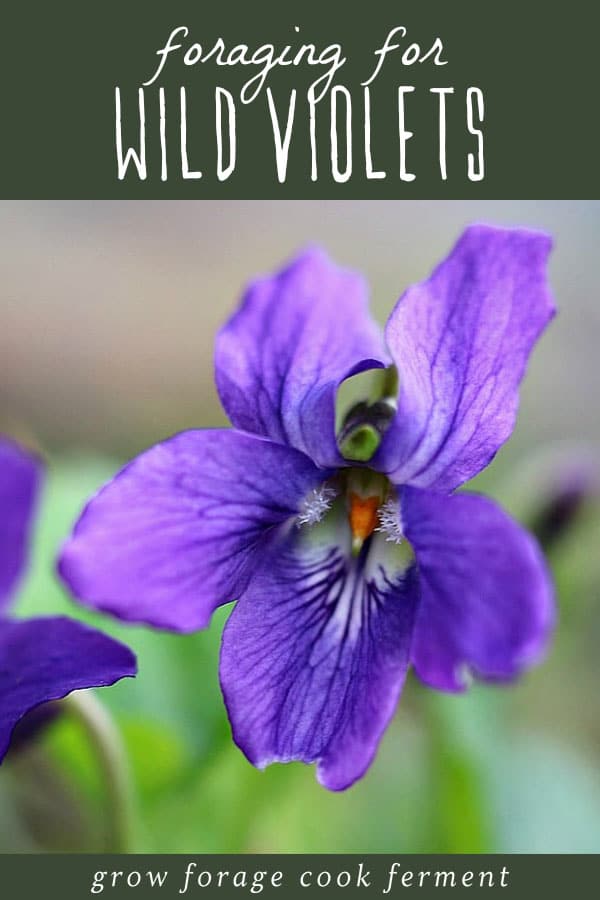
Want to save this post for later?
Wildcrafting Weeds
If you want to learn more about the edible and medicinal weeds that surround us and how to use them, check out my eBook: Wildcrafting Weeds: 20 Easy to Forage Edible and Medicinal Plants (that might be growing in your backyard)!
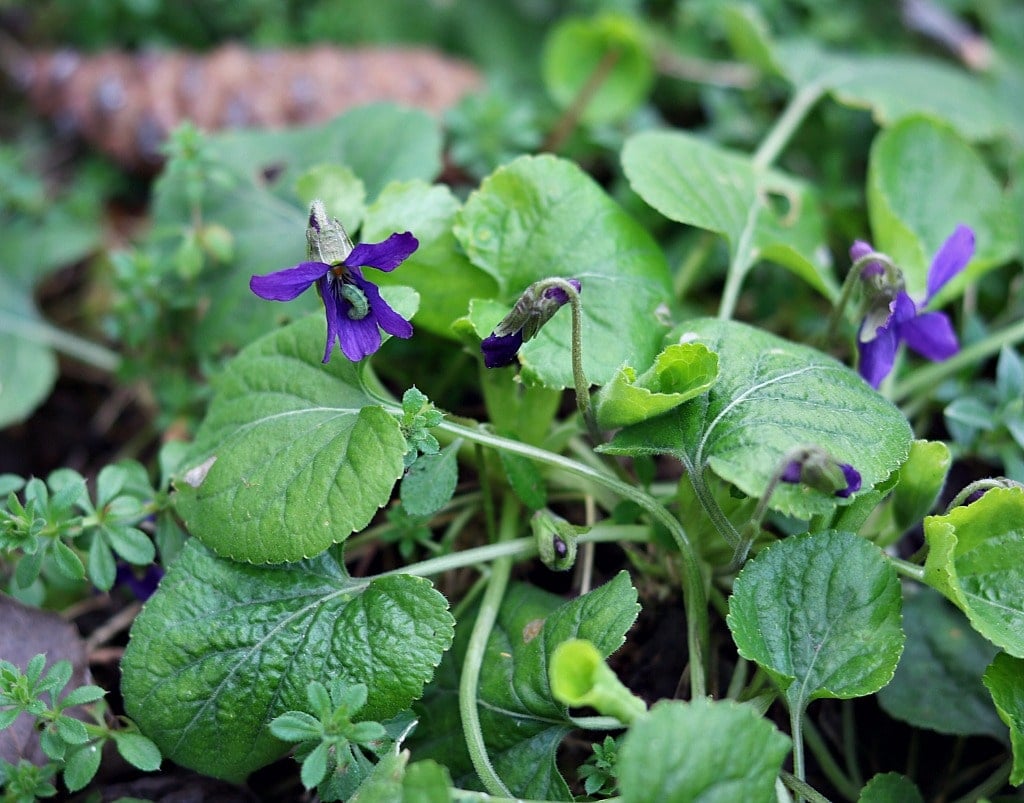
Wild Violets in Early Spring
I think the thing that I love most about wild violets is that they are usually the first flower to show their face in early spring. Actually, where we live in Southern Oregon they come up in mid-February!
These little purple flowers give us a nice little foreshadowing of spring when we’re still in the midst of winter, which is a welcome sight.
Wild violets grow plentifully right in our backyard under the apple tree, which makes foraging for them rather easy.
Even if you don’t have them in your yard, foraging for wild violets usually isn’t difficult, as they grow almost everywhere!
Related: What to Forage in Spring: 20 Edible and Medicinal Plants and Fungi, 13 Early Spring Edible Wild Greens
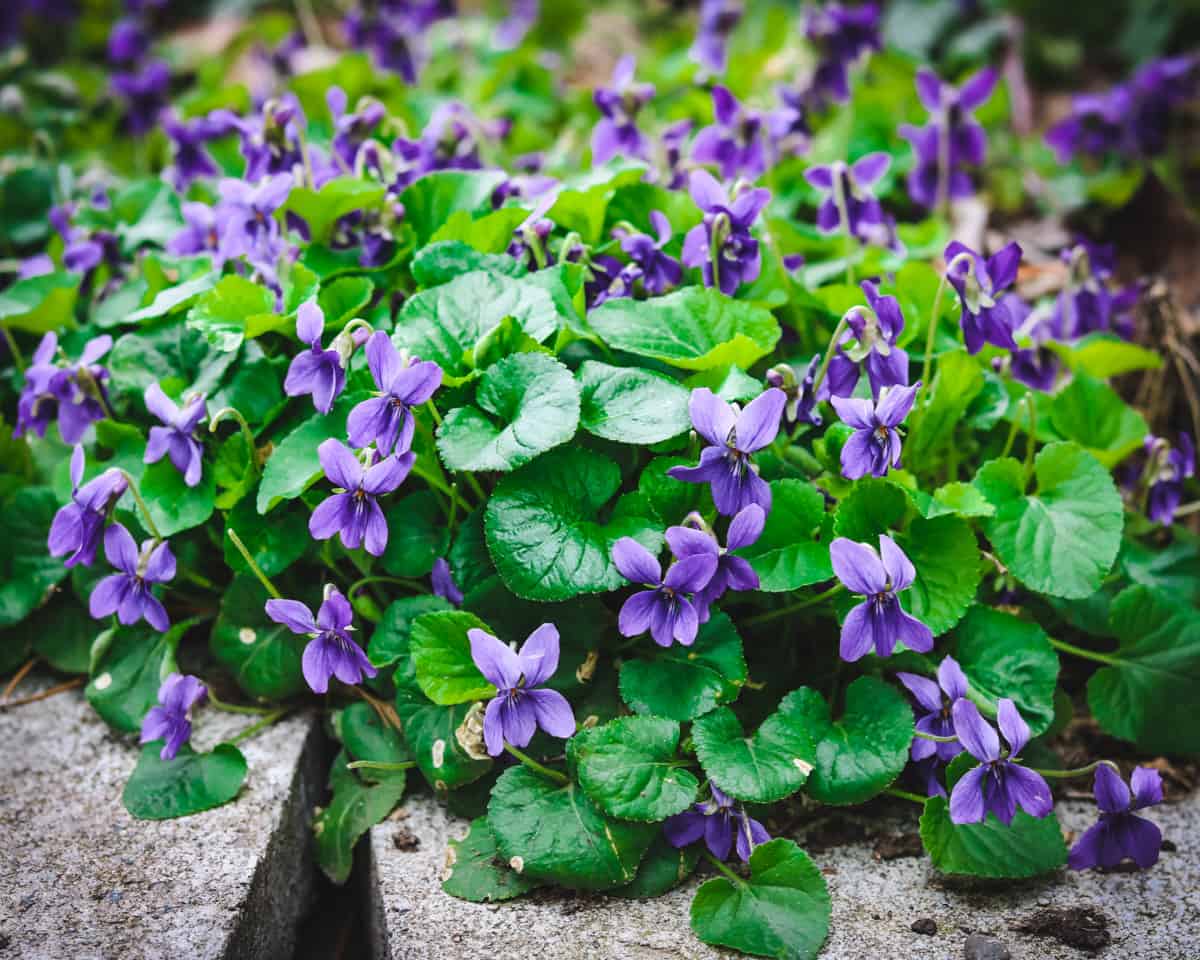
Get recipes using wild violet, lilac, forsythia, chive, calendula, lavender, white clover, nasturtium, elderflower, yarrow, rose, and Queen Anne’s lace flowers in my ebook Edible Flower Recipes: Infusions, Syrups, Jellies, Beverages, & Snacks!
Identifying Wild Violets
Wild violets are in the Viola genus, which also includes common garden violas.
There are many varieties of wild violets, with Viola odorata and Viola sororia being the most common types for foraging.
While many violets have purple flowers, some are blue, yellow, white or multicolored. Yellow violet varieties aren’t used as often because they tend to have a laxative effect.
Wild violets are a low growing plant that prefers a shady, wooded area with rich soil.
They have a basal rosette of toothed, heart shaped leaves, and drooping flowers with five petals that do not produce seeds.
Interestingly enough, tiny round black seeds are produced from non-edible brown flowers at ground level.
Wild violets mainly reproduce via underground rhizomes that are not edible.
One important thing to note if you live in certain coastal regions of Oregon, Long Beach Washington, or the northern California coast:
The federally threatened Oregon Silverspot Butterfly and Myrtle’s Silverspot Butterfly are reliant on early blue violets (Viola adunca) to survive. There’s a risk of these species becoming extinct from the west coast, so it’s good to be extra careful when harvesting violets in these locations, and possibly not harvesting any at all if you are within the habitat of these rare butterflies.
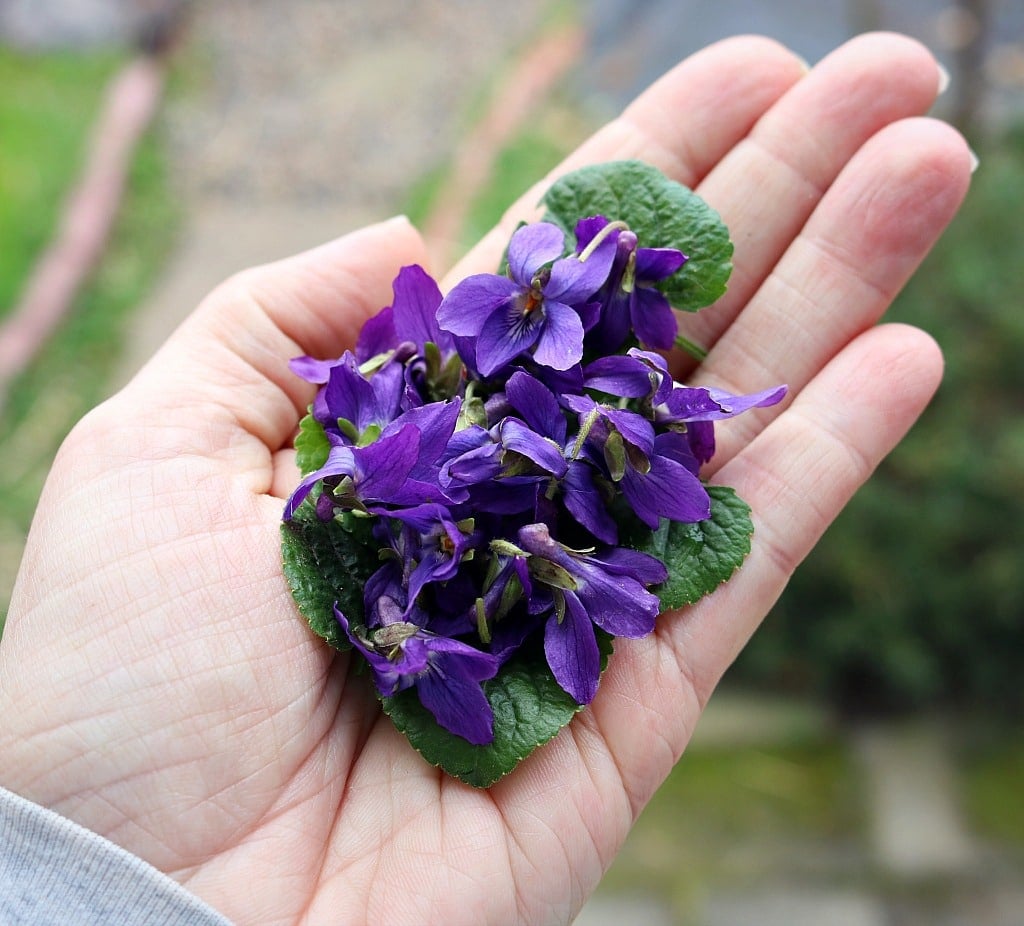
Wild Violet Look-alikes
There is only one wild violet look-alike that you need to be aware of and that is lesser celandine (Ficaria verna) which is toxic.
While lesser celandine has yellow flowers that don’t resemble wild violets at all, it has very similar heart-shaped leaves.
Because of this it is safest to wait until wild violet blooms before harvesting to be certain of identification.
Wild violets are not the same as African violets (Saintpaulias spp), a common house plant which are not edible at all.
Edible Uses of Wild Violets
Both the leaves and blossoms are edible, either raw or cooked, and are extremely high in vitamin C.
The flowers are a wonderful late winter or early spring treat, and are often made into violet jelly or violet syrup.
My favorite way to use violet flowers is in violet infused vinegar!
These wild violet muffins sound pretty amazing as well.
Violet leaves can either be eaten raw in a lovely wild greens salad, sauteed or steamed, or made into a tea.
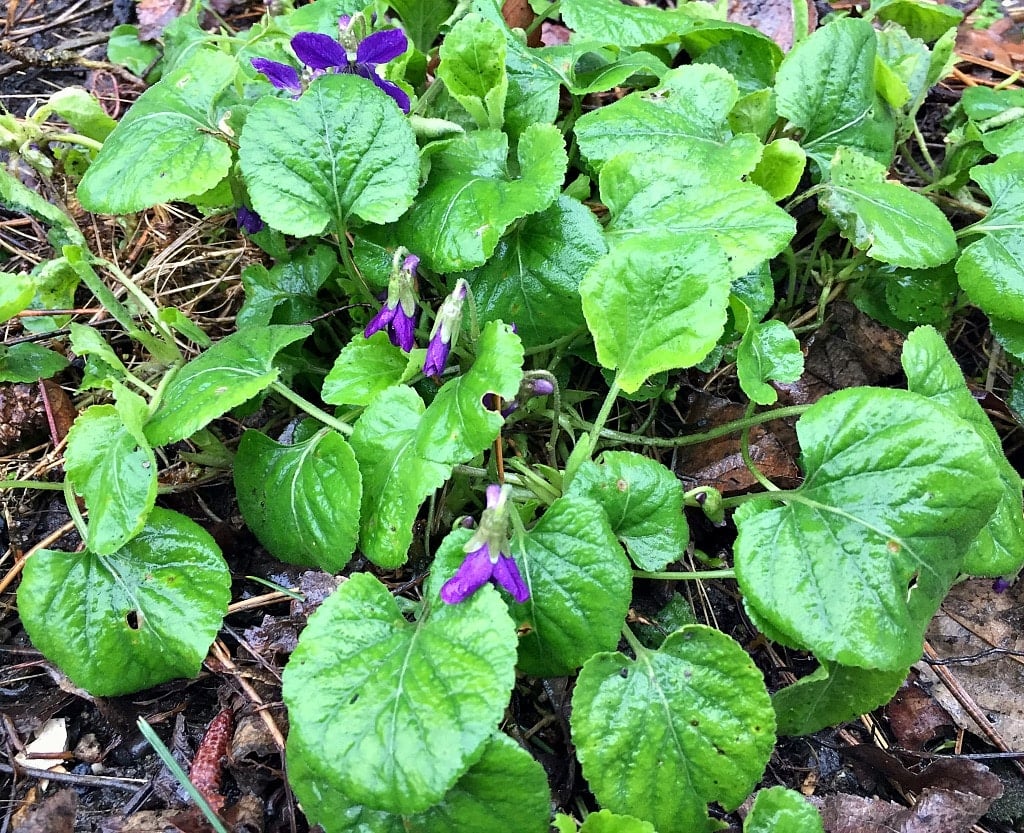
Medicinal Uses of Wild Violets
Violets leaves are highly medicinal, with a soothing mucilaginous property. They are antioxidant, anti-inflammatory, and a blood cleanser.
They are good for coughs and colds, and can be made into a violet leaf and honey cough syrup.
Violets can also be used topically for skin conditions like eczema, dry skin, bug bites, and varicose veins.
Here are some homemade recipes for violet leaf balm and violet lotion that can provide some relief.
Violet flowers and leaves also make a great addition to soap. Try this wild violet soap or this violet leaf soap.
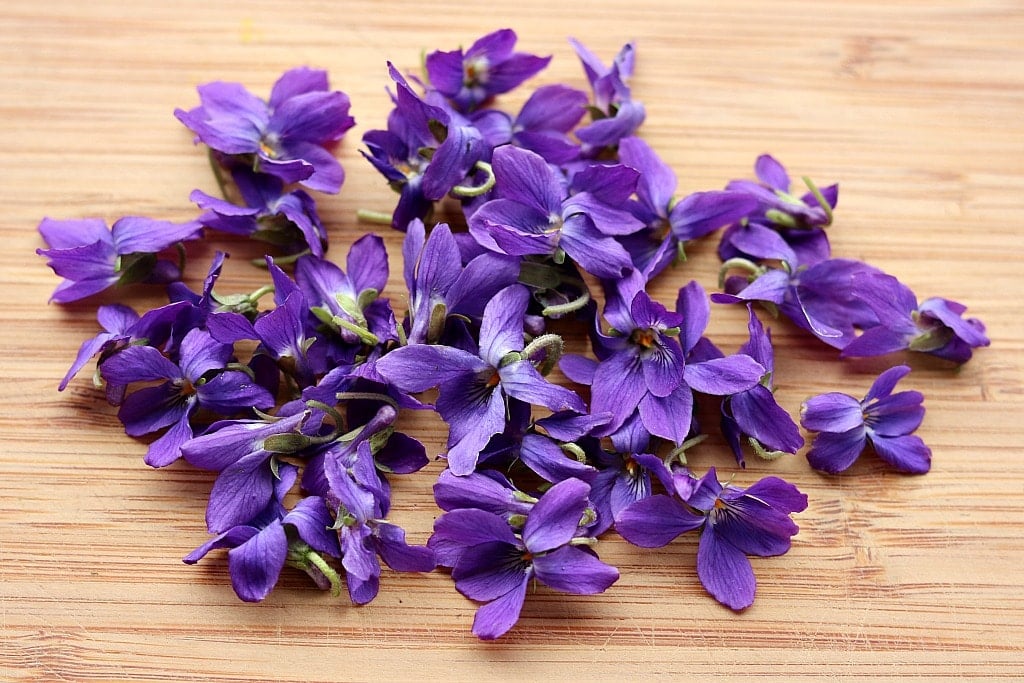
If you can’t find any wild violets, or if it’s the wrong season, you can purchase dried violet leaf from Mountain Rose Herbs (my favorite place to get high-quality, organic dried herbs).
A batch of homemade violet syrup is a great way to use up some of these edible flowers!
I hope this post inspires you to go foraging for wild violets! They are awesome little spring flowers that have so many great uses.
How do you like to use wild violets?




Hello. I’m a bit curious. Several years ago I have purple violets on my front lawn. I dug some up to put in my garden because they are my favourite flower. Now I can’t find any purple ones, just white. Is this normal?
Hi Bernadette. That’s a really good question! I just did a little research and it sounds like if the soil pH in your garden is different from that of your front lawn, it can alter the color of the flower.
I have a lot of yellow violets, never used them because of high saponin content but would probably be alright to use topical? Or also in soap.
For Violet leaves, Is there a limit for how much to eat at one time?
If I made a salad with mainly violet leaves perhaps.
No, that should be totally fine.
Hi! I’m trying so hard to figure put what thus little wild flower is growing in my yard. It’s really tiny and has violet characteristics. It’s 5 leaves with white and purple tint but honestly almost looks blue. It has a yellow spot on the bottom leaves and streaks of dark purple in the petals. Im trying to upload a picture of it but can’t get it to. I’ve looked for a couple weeks online and in books and can not seem to find this flower anywhere. Can you help me haha?
Hi Misty. It’s really hard for me to say with just a description. It sounds like wild violet, but I honestly don’t know. There are several mobile apps out there (Plant Snap and iNaturalist are good ones) that you can upload the picture to and they’ll give you a good recommendation of what it may be.
Thank you. I haven’t looked into any of those but now I definitely will now. I appreciate your time and help.
This sounds like it might be Jonny Jump-Ups (a tiny variety of pansies)
I’ve done some more research and you are right. Thank you for the reply. I had just started trying to learn about foraging and have since learned alot haha.
I’ve just recently come across your site. One thing that keeps me from foraging is insecurity about what chemicals might have been used on the soil or the plants themselves. What advice do you have about this when it comes to sourcing for foraging? I mean, the whole point of foraging is to collect from a spot where something is abundant and free and that’s usually not your own backyard!
I’m not the site owner, but if I have a question about the source location, I usually either find out about its soil quality from other sources or gather seeds to plant in my controlled location (backyard). You might also look at the local biodiversity. If it has a lot of different kinds of plants, it’s unlikely they’ll have been using herbicides. Other pesticides I dunno about but at least there’s that thought.
I am lucky that my yard has lots of these violets. However, it also has violets thay have flowers that are mainly white with just a streak of purple in the center. Are the white flowered Violets just as useful?
Yes, they’re also identical aside from the color.
They’re called “Confederate Violets” and can be used just as the purple ones are.
Hi, it’s very interesting for me, Have you any image of that.
I have a lot of these growing in my yard and I have always moved and transplanted them into areas for the deer that come to visit. They love to eat them as we love to watch them :) I now will forage for us as well!!
Great article but it would be more helpful to show the look-a-likes that we’re not supposed to eat in photo alongside the edible violet. Everyone just says what not to eat, but never identifies them.
Lauren Lewis: You might find this link helpful. It does show some of the non-edible plants. Excellent pictures there.
Oops, it would be more helpful if I had included the link. LOL https://foragedfoodie.blogspot.com/2017/03/foraging-for-wild-violets.html
I have some flowers growing in the yard each year but that I wondered if they’re violets but only have 4 petals instead of 5.Could some types have 4?
Hmm, everything I’ve read has said 5 petals. I’d have to see a picture to be sure!
This plant is a dicot which have 4 or 5 leaves.
Sounds good for a mead!!! I’ll be collecting and drying these next year.
What about the violet roots? Do you eat them? Raw? Cooked?
Can you dig them up and plant them in containers for the patio?
Definitely! I’ve transplanted them many times. My neighbors gladly let me take them out of their lawns to put in mine! 🤣
I just picked a a bunch from my backyard and can’t wait to try out the vinegar. Great info. Thanks!
i am harvesting tomorrow….question..can the white ones be dried or edible like the purple ons….and can the leaves be dried for teas
I also wonder this!
Thank You for the information as I am always looking for Blood cleansers .I have a blood clot in my leg and its been there since 2004 and I have been on warfin since then,but lately I have been looking into natural cures and cleansers and I can the feel and see the difference in my leg,Thank You and if you know of any other little helpers please let me know ?
My sisters and I used to pick violets for our mother. She would always tell us to leave some for the bees. What a wonderful article about these sweet little flowers. I have numerous violet plants in my yard. Some of the violets are white and some are pink.
Don’t know why, but your post just made me teary-eyed…????
You are rememebering the glorious days of picking these and all the older women got so excited. It’s like eating comfort food. Full of love and memories.
A friend sent me your website. I am delighted to have it and sent a request to get your blog and look forward to reading more about your homesteading life . I am a homesteader in SW Michigan, blogger, writer/photographer and forager as well as a Reiki master, herbalist and chicken keepers. I have tons of violets and give them to my chickens in season with other fresh herbs which they adore. Blessings!
Donna at the Small House Big Sky Homestead
http://smallhousebigskyhomestead.wordpress.com
Hello, I am in Southern Oregon too! While I have a couple of these sweet little plants in my yard, they seem to come back fewer and fewer every year. Any tips for encouraging more growth? I would really like more, and different colored flowers.
PS. Just 2 days ago I was out taking pictures of the ones in my yard. I’d love to share one with you if you’d like. ????
Cloverkraut, violets are super simple to propogate. Try this….Dig up the non blooming baby plants and do both of these tips: 1) Put some violets in large pots and set in a shady and damp place (like any transplant, keep them damp and water them well) and watch them grow. By fall they will be ready to transplant into the ground. I dig out chunks of violets each spring and each fall and transplant them to new beds where I want them to spread out. They are super easy to transplant IF your soil is rich and well amended and you bed is well mulched in bark chips.
I have zillions of wild violets, but I am very careful with the harvest of them and dandelions as they are some of the first “bee flowers ” available.
What a fabulous post with so many great ideas (and links) to try. Our violets have just shown up and there are heaps of them! Now I just need to wait for a sunny day (don’t I?) to collect – hopefully it comes before the violets close up shop.
Love your site!
I don’t need to go far. I have them in my yard and garden. So, when I pick them I should probably remove the little green worms, right? LOL
Thanks for the great ideas. It’s hard to pick them because they are so cute and colorful this time of year. They have the most awesome sweet smell, too. I put them in my very tiny pottery vase on the kitchen window sill.